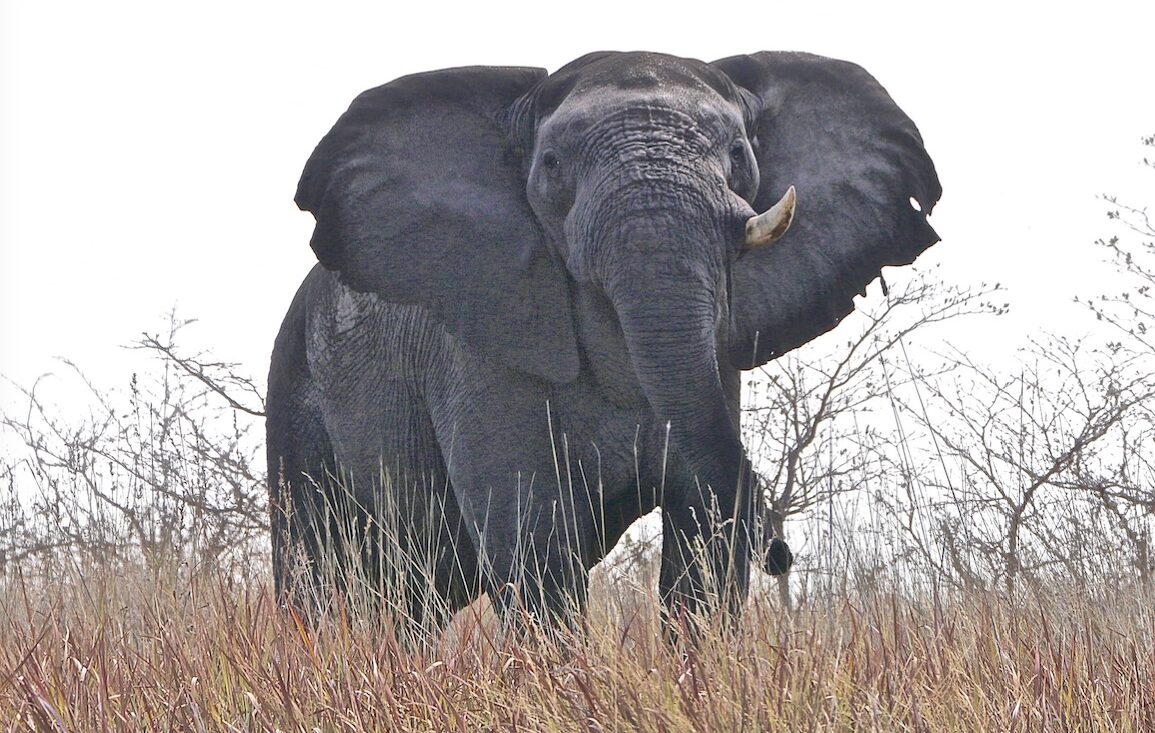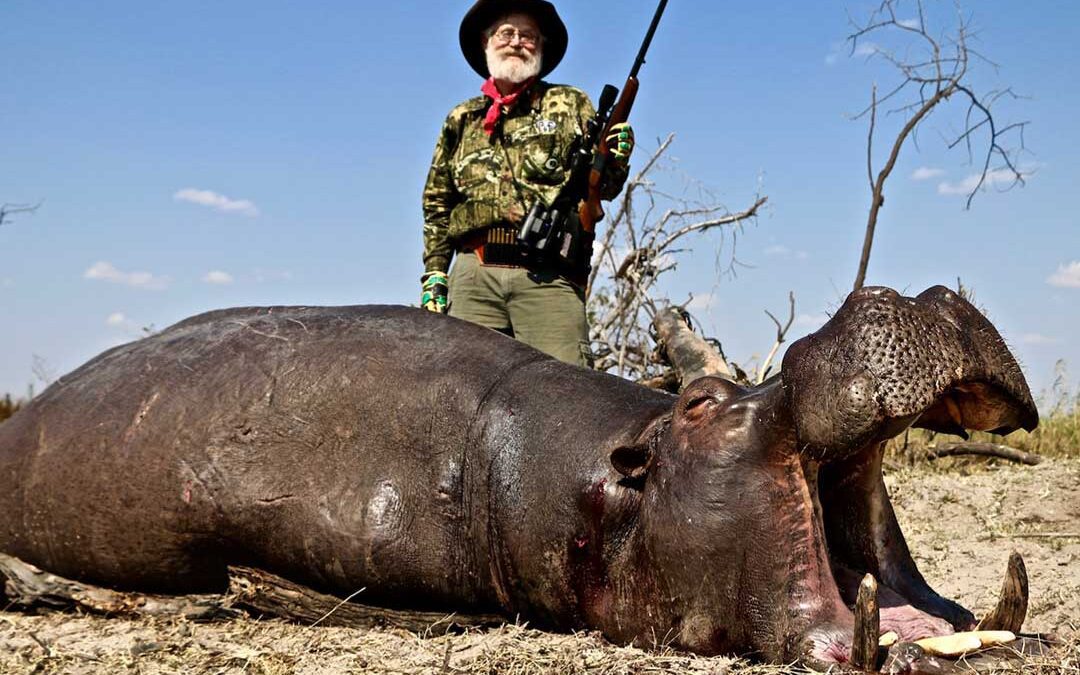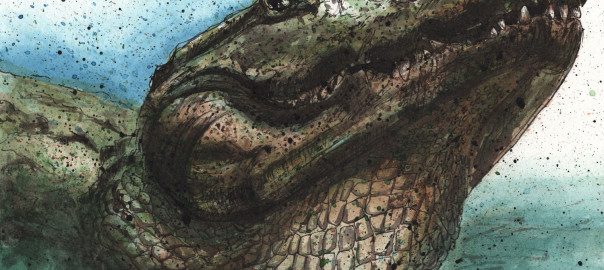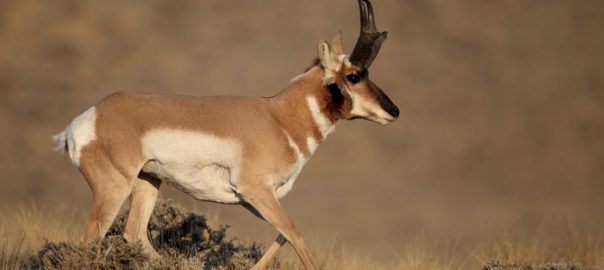Those lyrics kept running through my mind as I stowed gear in Omujeve Safari’s Ivory Camp on the backwater banks of the Kwando River in Namibia’s Zambezi Strip. The comfortable en-suite tent would serve as home for the next ten days. Unpacking I heard Louis Kotze, my PH and friend from several previous safaris to Namibia; “Soon as you unpack, grab your rifle and we will make certain it is still properly sighted-in. After that we’ll take a tour to see if we can find an impala. Our trackers need fresh, red meat.” I loved Louie’s suggestion.
I quickly switched to hunting duds, laced my Kenetrek boots and gaiters, and put my binos and a mixed box of Hornady’s 400-graind DGX and DGS .450-400 NE 3” ammo into my day pack. I grabbed my Ruger No. 1 as I headed out the door toward the kitchen to meet Louie and our trackers.
Upon stepping into the “kitchen area,” Louie handed me a tall mug of strong, delicious “cowboy coffee.”
“We’ve got three hours of hunting light remaining this afternoon,” he said. “Really not sufficient time to get on the river to look for hippo. We’ll start hunting the Kwando tomorrow. As you’ll remember from your last hunt looking for buffalo, the Kwando has a lot of hippos.
“As you are aware, the hippo permit we have for you is an ‘own use permit’, which simply means the entire hippo goes to local and regional villagers to be used by them for meat. That includes flesh, skin, bones, skull and teeth. Soon as you sign the proper paperwork, and we make certain your Ruger is shooting properly we will go collect an impala.”

Thirty minutes later I put two shots into the same hole at 50 yards, the distance Omujeve had suggested I sight-in for. I was ready!
Driving toward a remote waterhole we spotted a wide variety of the Zambezi Strip’s species; two small herds of elephant, four sable antelope (one male was huge), a couple of roan antelope, seven greater kudu (one which approached 60-inches in horn length) and a hand full of warthogs. When we got to within about 800 yards shy of the waterhole we stopped and continued on foot. A quarter of a mile into our walk we spotted ten impalas. One was a mature ram. “Stay low. Let’s get to within two hundred yards,” suggested the PH. I followed.
Taking advantage of brush and trees with a slight breeze in our face we cut the distance to within 125 yards. There Louie set up shooting sticks. I rested my single-shot Ruger in the crux of the sticks, pushed safety to fire, steadied crosshairs on the ram’s shoulder, then gently tugged the trigger. At the shot the nicely fleshed impala pitched forward and was down.
A bit later, we watched the last golden rays of day turn to darkness while seated around a warming camp fire listening to the late evening’s wildlife symphony and partaking of sundowners! Ah…I love safari life!
We were on the Kwando’s water at first light, listening and looking for hippos. My ultimate goal was to take a hippo on land rather than in the water as my first had been.
During the course of the day we saw many elephants and numerous crocs, the largest over 13 feet long. When I commented about the croc’s size, Louie replied, “Nice, but not the biggest on this stretch of the river. We’ve got a couple of croc baits set up near where we’ll concentrate our hippo hunt. Know of at least two in the area that will will likely exceed 15 feet.”
The next two days we spent considerable time cruising the river, walking the bank and back water pools looking for hippos. We saw several pods in the the water, but none on land. We found sandy “beaches” where hippos had “sunned.” We also found numerous hippo trails leading away from and returning to the river and backwater ponds. We saw where they spent nights foraging. But, we could not find a “landed hippo.”
The third day went almost exactly as the first two, seeing hippos but not on land. One of the highlights of the day was suddenly encountering a monstrous, ancient broken-tusked bull elephant. He appeared out of nowhere and made threatening moves toward us. We retreated, following a trail through a densely vegetated, riverine thicket. Just as we crawled out of the dense river cane there stood another bull elephant. This one a young bull, obviously upset and perturbed.
“Don’t shoot!” warned Louie. Even though I had no intention of shooting, I made certain I had a Hornady solid chambered. We backed up slowly. All the while my PH was “talking” to the young bull. Evidently, he understood Louie, because after dramatically demonstrating his displeasure with us, he turned and walked away.
Around the campfire that night, I raised a wee dram high and predicted, “Tomorrow!”
“So it shall be!” replied Louie.
Next day about ten o’clock we left the Kwando and slipped in to the back end of a stream which flowed into the river. The year previous, looking for Cape buffalo there Louie and I had seen a large pod of hippos including two big bulls. And that wasn’t all.
“Larry, the biggest croc I know of in this area lives here,” said Louie. “Our bait is set up on the other side of this little bay. Lots of crocs about. Watch where you put your feet and for any kind of movement.”
Moving slowly, mid-thigh deep along an obvious croc/hippo water trail, we eased forward. Tall river reeds and cane obscured left and right vision. About a hundred yards into our “wade,” we could partially see a sandy beach about twenty yards ahead. There lay three hippos, one a huge, old bull laying broadside.
Unfortunately, the river cane was too tall and thick to get a shot from where we were. But fortunately, a stiff breeze blew from the hippos to us. Not wishing to be standing thigh deep in a watery hippo escape route, the same one a wounded hippo or one of his two compadres might take after I shot, I crawled to higher ground on my right and then slowly, cautiously moved a bit closer. At a distance of just beyond ten yards I could see most of the bedded hippo. If, or rather, when he stood up, there was a good chance I would be able to see his vitals.
I waited, mentally going over again and again what I knew about hippo anatomy. Perhaps my best shot would be to try to hit the spinal cord. Meanwhile, the hippo did not move. Ten minutes passed, then twenty minutes. Legs and back ached, protesting the contorted position I was in. I did not take my eyes off of the hippo. I tried to imagine exactly where his spinal column was located and where I could make a precise shot to put the big bull down where he stood. I did not want him to get into the water. If he did, we might have to “wrestle” the hippo from the gargantuan crocodiles in the immediate area. I did not want that to happen.
I waited, waited, and waited some more. Finally, I saw the ancient hippo stir and start to get up. As soon as he was on all four feet, I pushed the Number 1’s safety to fire, settled the crosshairs just below and behind his ear. At the shot the monster dropped in his tracks. With practiced speed I ejected the spent Hornady brass, chambered a second round, repeated the process, then shot him a third time. Later the trackers wanted to see my No. 1 to determine how I was able to shoot a second and third shot so rapidly. I smiled.
The bull never moved after my first shot, but I am one who believes in quick follow up shots regardless of the species hunted, but particularly when hunting dangerous game.
At the bull’s side I marveled at his overall length and depth of body. It appeared he was easily twelve feet long from tip of his muzzle to the tip of his tail. HUGE to say the least! I was thrilled and excited, but also proud and pleased to know that all of the hippo would be used by protein-starved local and regional villagers.
After appropriate congratulations and photos, Louie called his crew to reduce the hippo into manageable cuts to be loaded on to vehicles to be delivered to a village about thirty miles distant.
Young and old smiling faces greeted our six vehicle loads of hippo when we pulled into the village compound. We were also met by a representative of the village, who’s duty and job it was to be certain all received their fair share. Before leaving, many of the villagers came up to say “Thank You!” I overheard one younger couple who spoke excellent English say, “Like Christmas in July!” I guess they too, wanted a hippopotamus for Christmas!




